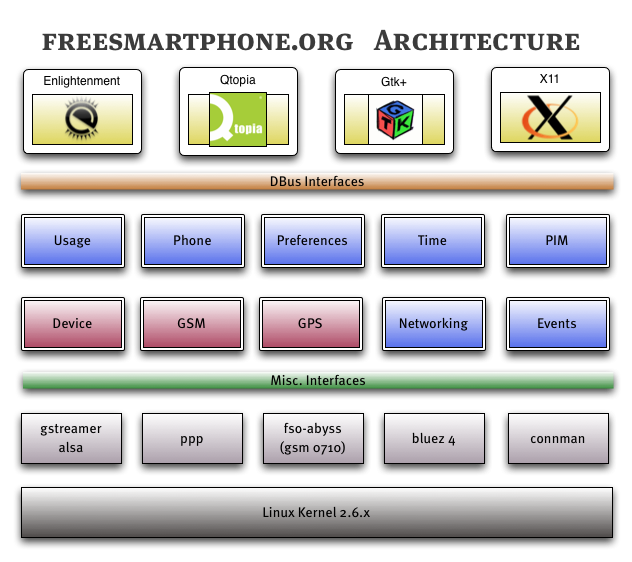OpenmokoFramework
From Openmoko
(→Audio) |
(→Audio) |
||
| Line 59: | Line 59: | ||
'''Gstreamer''' is to be used for all kinds of event sounds where a) multiple audio formats need to be supported and b) a latency of about one second is acceptable. This goes for e.g. ring tones, welcome tones, plug indication. | '''Gstreamer''' is to be used for all kinds of event sounds where a) multiple audio formats need to be supported and b) a latency of about one second is acceptable. This goes for e.g. ring tones, welcome tones, plug indication. | ||
| + | |||
'''Pulseaudio''' is to be used for event sounds, where low-latency is necessary, e.g. touch click sounds and | '''Pulseaudio''' is to be used for event sounds, where low-latency is necessary, e.g. touch click sounds and | ||
Revision as of 18:42, 5 May 2008
Note: This is the (ongoing) description of the new framework architecture. See OpenmokoOldFramework for the framework architecture of 2007.1 and 2007.2
Contents |
Purposes
- Give people the infrastructure to create solid and exciting software products based on the Openmoko platform
- Support competing UIs while collaborating on developing services
- Encourage framework users (e.g. application developers) to also contribute to the framework
Requirements
- Make it simple
- Concentrate on core services
- Be programming language agnostic
- Be UI toolkit agnostic
- Try to reuse existing technologies as much as possible, but not at the cost of a bad API
How to achieve that technically
- Chose Dbus as the collaboration line. Below dbus, we can work together. Above dbus, we can differentiate.
- Expose features through dbus APIs implemented by UI-agnostic and language-agnostic services (daemons).
- Optimize for Openmoko devices, but support multiple architectures and purposes through plugin interfaces and suitable hardware abstraction mechanisms.
- Be not afraid of reinventing the wheel for a wheel-barrow if all the existing wheels are made for sports cars.
Mandatory Readings
- Frameworks exist for conceptual integrity
- Ten ways to make more humane open source software
- FreeSmartPhone.org Wiki
What this is NOT about
This initiative does not cover low level services such as
- Bootloader, Kernel, or System Init.
This initiative does not cover high level services such as
- X-Window-System, Window Manager, UI Toolkits,
- Application Launchers, Applications, or Fancy UIs.
Architectural Overview
Software Components
We differenciate between low-level and high-level services -- dbus will be used to communicate horizontally and vertically.
Low-Level Services
Device Control
This is about peripheral control, i.e. managing power for individual subsystems such as
- GSM, WiFi, Bluetooth, GPS, as well as
- Backlight brightness and power,
- turning LEDs on and off, etc.
It's also about access to
- charging, suspend/resume,
- accellerometers, and buttons.
It will monitor the user's activity to
- Change to powersaving modes
- Lock the device
Audio
The low level audio service relies on a working alsa device driver. On top of that, there are two components:
- gstreamer
- pulseaudio
Gstreamer is to be used for all kinds of event sounds where a) multiple audio formats need to be supported and b) a latency of about one second is acceptable. This goes for e.g. ring tones, welcome tones, plug indication.
Pulseaudio is to be used for event sounds, where low-latency is necessary, e.g. touch click sounds and
Pulseaudio is our general all-purpose mixer. Gstreamer will use the pulseaudio sink to feed audio through.
GSM
TBD
Bluetooth
TBD
We base on the official Linux Bluetooth subsystem here, which is BlueZ.
GPS
TBD
We base on Gypsy here.
Network (LL)
Wifi USB Options: Networkmanager or Intel Connection Manager
High Level
Usage
- coordinating application I/O requirements (think reference counting for I/O requirements)
- might use fd.o policy API
Events
- signaling events via I/O (ringing, blinking, vibrating)
- might use fd.o notification API
PIM
- intelligent storage database
- GSoC2008
Context
- Intelligent context API, integrating location as one -- among other -- sources
TBD Reference Geoclue
Telephony
- Voice
- Data
Preferences
- settings database
Network
- high level networking queries
Implementation Tasks
What's there
- bluez
- gypsy
- geoclue
- py-odeviced
- pygsmd
- gsmd0710muxd
- networkmanager or intel connection manager
- ppp
What's missing or not fully completed
- py-ophoned
- py-odeviced
- pimd (GSoC 2008 project)
- eventd
- usaged
- preferencesd
- contextd
The role of Python
Where we write new code, we will use Python to implement the dbus services. The reason for that being the rapid prototyping nature of Python and the emphasis on the Dbus APIs. Using Python, the turnaround times to experiment with APIs are incredibly faster than for using a compiled language such as C or C++.
Once the APIs have been used by application programmers, we can start profiling and possibly reimplement some of the services with daemons written in Vala, if necessary. We might as well succeed in improving performance by using Pyrex/Cython/Ctypes to keep the benefits of Python.
Team & Roadmap
Team
- Michael 'Mickey' Lauer
- Guillaume Chereau
- Jan 'Shoragan' Luebbe
- Holger 'Zecke' Freyther
Roadmap
Milestone 1:
Milestone 2:
Milestone 3:

